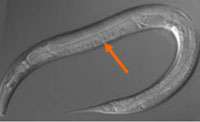Self-fertilizing worms lose thousands of active genes in reproduction process

(Phys.org)—A new University of Maryland study of worms that reproduce without a mate shows that not only have these creatures lost their mojo in the dating game of evolution, they've lost thousands of genes as a consequence.
In a paper appearing in the Nov. 12 issue of Current Biology, a team from the University of Maryland reports that the self-fertilizing nematodes, or roundworms, they studied have only about two thirds as many active genes as their ancestors, which reproduced exclusively through male-female mating.
"Our study confirms that when females shift from mating with males to fertilizing their own eggs, the number of genes utilized by that species shrinks," says the study's leader, Eric Haag, evolutionary biologist and associate professor of Biology at the University of Maryland.
"We also found that the genes activated only in males or females seem to be especially likely to be lost in the self-fertilizing species. Overall, our study forges a fascinating link between how a species reproduces and the size and content of its genome."
Cliffs Notes Version of the Genome
Haag's team looked at the genomes of two common species of roundworm, Caenorhabditis elegans and the related C. briggsae. About the size of a dust speck, these worms have, over a few millions of years, evolved from animals with females and males into species where the female has become a hermaphrodite that creates her own sperm to fertilize her eggs. In these species, males are very rare, and no mating is needed for reproduction.
Haag has done other evolutionary studies on these worms, but his idea to compare the genomes of hermaphrodites and their close relatives came from ongoing genome projects. "The genome sequences have ambiguities that make comparing their sizes tricky, but I noticed they were always bigger in the species that had typical male-female sexes," Haag says.
Applying cutting edge sequencing technology in collaboration with genomics researchers from the National Institutes of Health, Haag's team compared the complete sets of active genes (the transcriptomes) in males and hermaphrodites of C. elegans and C. briggsae to males and females of three related species that still reproduce exclusively by mating. This adds information that DNA sequencing alone cannot, such as differences in how each sex uses a gene.
"C. elegans and C. briggsae seem to have the 'Cliffs Notes' version of the nematode genome," says Haag. They have the most critical genes of their ancestors, but have lost thousands of others. These include all sorts of genes, but those turned on only in males or only in females, and thus likely to be related to sex and reproduction, are especially likely to be lost.
"The lost male-active genes are likely used for aspects of sperm production or delivery, while many lost female-active genes encode proteins that regulate other genes. We speculate that many of the lost genes were needed for optimal mating, and may no longer be necessary."
What's Lost is Lost
Haag says that while the hermaphrodite life has worked well for C. elegans and C. briggsae to date, their self-sufficient sex lives could set them up for extinction.
"Others have shown that hermaphrodite worms have a tendency to lose DNA in the lab, and our results indicate this is happening in nature, too. Genes related to sex are especially likely to disappear. Once a sex-related gene is lost, it probably stays lost," Haag says. "Over time this reduces mating further, and each cycle the genome gets smaller. But if variation becomes important again, and they try to go back to mating, they can't do it well anymore. Self-fertilizing species go extinct faster than those that keep mating, and this may be why."
Haag says the study also shows that an organism's genome can change a great deal and not make a difference to its day-to-day survival. "It's often thought that the genome is like a machine that's been engineered, and that all the nuts and bolts are important and must stay in place or the organism stops working. This study is one of a number that show many of those nuts and bolts aren't necessary after all."
Journal information: Current Biology
Provided by University of Maryland
















